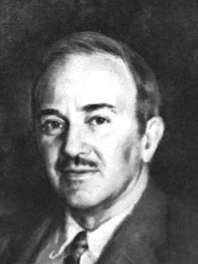Edward Chamberlin
Edward H. Chamberlin | |
|---|---|
 | |
| Born | May 18, 1899 La Conner, Washington |
| Died | July 16, 1967 (aged 68) |
| Nationality | American |
| Institution | Harvard University |
| Field | Microeconomics |
| School or tradition | Neoclassical economics |
| Alma mater | University of Iowa University of Michigan Harvard University |
| Doctoral advisor | Allyn Abbott Young |
| Contributions | Monopolistic competition |
Edward Hastings Chamberlin (May 18, 1899 – July 16, 1967) was an American economist. He was born in La Conner, Washington, and died in Cambridge, Massachusetts.
Chamberlin studied first at the University of Iowa (where he was influenced by Frank H. Knight), then pursued graduate-level studies at the University of Michigan, eventually receiving his Ph.D. from Harvard University in 1927.
Economics[]
For most of his career Edward Chamberlin taught economics at Harvard (1937–1967). He made significant contributions to microeconomics, particularly on competition theory and consumer choice, and their connection to prices. Edward Chamberlin coined the term "product differentiation" to describe how a supplier may be able to charge a greater amount for a product than perfect competition would allow.
His most significant contribution was the Chamberlinian monopolistic competition theory. Chamberlin published his book The Theory of Monopolistic Competition in 1933, the same year that Joan Robinson published her book on the same topic: The Economics of Imperfect Competition, so these two economists can be regarded as the parents of the modern study of imperfect competition. Chamberlain's book is often compared to Robinson's book The Economics of Imperfect Competition, in which Robinson coined the term "monopsony," which is used to describe the buyer converse of a seller monopoly. Monopsony is commonly applied to buyers of labour, where the employer has wage setting power that allows it to exercise Pigouvian exploitation[1] and pay workers less than their marginal productivity. Robinson used monopsony to describe the wage gap between women and men workers of equal productivity.[2]
Chamberlin is also considered one of the first theorists who applied the marginal revenue idea, which is implicit on Cournot's monopoly theory in the late 1920s and early 1930s.[3] Chamberlin is thought to have conducted "not only the first market experiment, but also the first economic experiment of any kind," with experiments he used in the classroom to illustrate how prices don't necessarily reach equilibrium.[4] Chamberlin concludes that most market prices are determined by monopolistic and competitive aspects.[3]
Chamberlin's theory of monopolistic competition is used by sociologist Harrison White in his "markets from networks" model of market structure and competition.
The works of Chamberlin, Robinson, and other contributors to the Structure-Conduct-Performance Paradigm were heavily discounted by game theorists in the 1960s, but Nobel-Prize winner Paul Krugman and others built the foundations of the by combining such theories of industrial structure with production functions that assumed significant economies of scale and scope.
Major works[]
- "Duopoly: Values where sellers are few", 1929, QJE
- "The Theory of Monopolistic Competition: A Re-orientation of the Theory of Value", Harvard University Press, 1933 1st ed. & 1962 8th ed.
- "Proportionality, Divisibility and Economics of Scale", 1948, QJE
- "An Experimental Imperfect Market", 1948, JPE
- "Product Heterogeneity and Public Policy", 1950, AER
- Monopolistic Competition Revisited, 1951
- "Impact of Recent Monopoly Theory on the Schumpeterian System", 1951, REStat
- "Full Cost and Monopolistic Competition", 1952, EJ
- "The Product as an Economic Variable", 1953, QJE
- "Some Aspects of Nonprice Competition", 1954, in Huegy, editor, Role and Nature of Competition
- "Measuring the Degree of Monopoly and Competition", 1954, in Chamberlin, editor, Monopoly and Competition and their Regulation
- "The Monopoly Power of Labor", 1957, in Wright, editor, Impact of the Union
- "On the Origin of Oligopoly", 1957, EJ
- Towards a More General Theory of Value, 1957
References[]
- ^ Persky, Joseph; Tsang, Herbert (1974). "Pigouvian Exploitation of Labor". The Review of Economics and Statistics. 56 (1): 52–57. doi:10.2307/1927526. JSTOR 1927526.
- ^ http://www.u.arizona.edu/~rlo/696i/Monopsony_Model_Latex.pdf
- ^ Jump up to: a b Brue, Stanley L.; Randy R. Grant (2008). The evolution of economic thought. Thomson. p. 543.
- ^ Ross Miller (2002). Paving Wall Street: Experimental Economics and the Quest for the Perfect Market. New York: John Wiley & Sons. pp. 73–74. ISBN 0-471-12198-3.
External links[]
- 1899 births
- 1967 deaths
- University of Iowa alumni
- University of Michigan alumni
- Harvard University alumni
- Harvard University faculty
- Distinguished Fellows of the American Economic Association
- People from La Conner, Washington
- Economists from Washington (state)
- 20th-century American economists